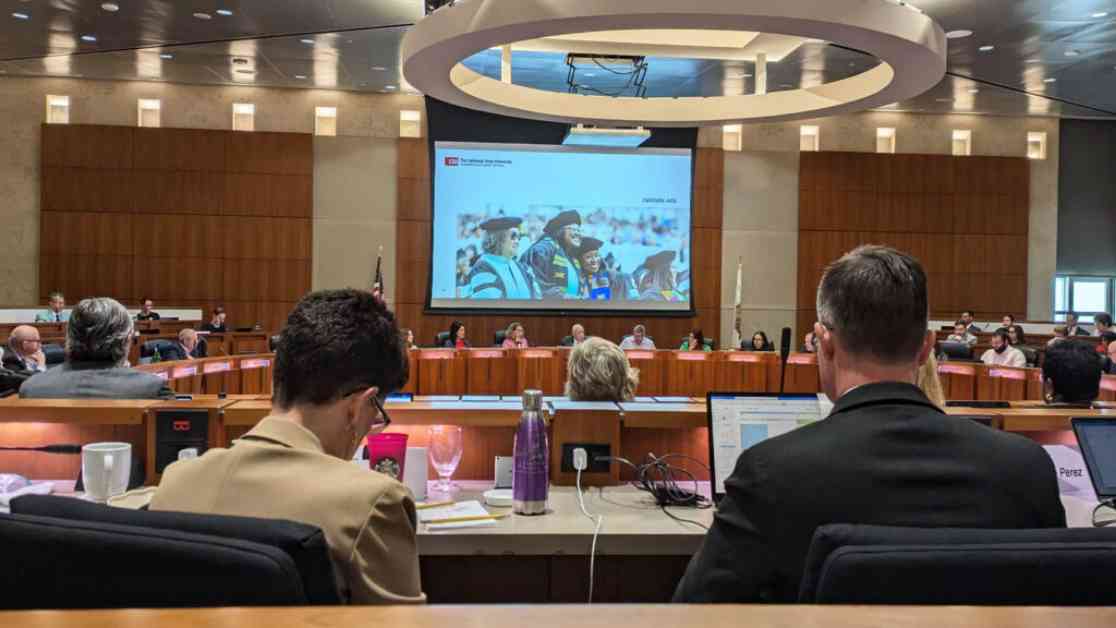Navigating Budget Cuts: Cal State Board Braces for Tough Year Ahead
As California State University officials convened for the July 2024 meeting of the board of trustees, the looming specter of a deepening budget gap cast a shadow over the proceedings. The state’s largest university system is grappling with financial challenges that threaten to reshape the landscape of higher education in California.
The appointment of Emily F. Cutrer as the new interim president of Sonoma State University was met with a stark reminder of the “enormous financial pressures” facing the institution. With a decline in fall 2023 enrollment of over 36% in the last decade, Sonoma State is just one of many campuses within the CSU system facing significant challenges.
The board of trustees meeting served as a critical juncture for campus leaders, who are striving to reverse declines in student enrollment and attract new students. Despite efforts to boost enrollment, cost-cutting measures may become a necessity for many campuses, as CSU officials cautioned. Board Chair Jack B. Clarke Jr. acknowledged the difficult decisions ahead for school presidents, emphasizing the need to manage limited resources effectively.
A bleak financial forecast looms on the horizon, with CSU potentially facing a staggering $1 billion budget gap in the 2025-26 school year. Diminishing state support for higher education and escalating costs pose significant hurdles for the university system. In response to these challenges, CSU has unveiled a plan to reallocate funds from campuses that fall short of enrollment targets to those where targets have been increased.
The system’s financial woes extend beyond enrollment issues, with major expenses including facilities and infrastructure projects, employee compensation costs, and legal obligations under mandates like Title IX. CSU Chief Financial Officer Steve Relyea cautioned trustees about the negative impacts on academic offerings and student support services that could result from inadequate funding.
Enrollment declines have already prompted cost-cutting measures at some CSU campuses, such as Cal State Channel Islands, San Francisco State, and Sonoma State. These institutions have resorted to strategies like delaying hiring, implementing voluntary separation programs, and even cutting entire programs like women’s water polo to save money. The financial strain has forced campus leaders to make tough choices in prioritizing budget allocations.
Sonoma State University, in particular, has weathered enrollment declines by slashing its base budget by millions of dollars. Spokesperson Jeffery Keating highlighted the school’s efforts to protect student services and academic programs while reducing faculty and staff headcount. Despite the budgetary challenges, Sonoma State remains committed to maintaining essential services like financial aid, health services, and career counseling for students.
The financial turbulence facing CSU has prompted a reevaluation of cost-saving measures across the university system. Chancellor Mildred García emphasized the need for mission-driven efficiency in the central office, aiming to streamline operations and reduce costs without compromising academic quality. The proposed merger of Cal Maritime with Cal Poly San Luis Obispo represents a strategic move to consolidate administrative functions and cut overhead costs.
The search for savings extends to individual campuses like Cal State Northridge, where administrators are implementing measures to reduce costs without sacrificing student success. From cutting nonessential expenses to delaying technology upgrades, these efforts aim to shield essential student services while tightening the university’s budget.
The uncertain financial outlook for CSU hinges on the state legislature’s funding decisions, which have historically played a significant role in the university system’s operating budget. Despite recent budget compromises that averted more drastic cuts, CSU faces continued financial challenges in the years ahead. Anticipated cuts to ongoing state funding and proposed spending-reimbursement maneuvers pose risks to the university’s financial stability.
In response to the funding crisis, CSU leaders are exploring alternative revenue sources and cost-saving strategies to mitigate the impact of budget shortfalls. Initiatives like year-round operations, public-private partnerships, and increased philanthropic support are being considered to bolster the university system’s financial resilience. The decision to implement tuition hikes has sparked debate among trustees, with some arguing that the additional revenue is necessary to preserve jobs and essential services.
As CSU grapples with the fallout of budget cuts and enrollment challenges, the path forward remains uncertain. The university system must navigate a complex financial landscape while balancing the needs of students, faculty, and staff. The coming year promises to be a test of resilience and adaptability as CSU confronts the harsh realities of fiscal austerity and seeks sustainable solutions for the future.
